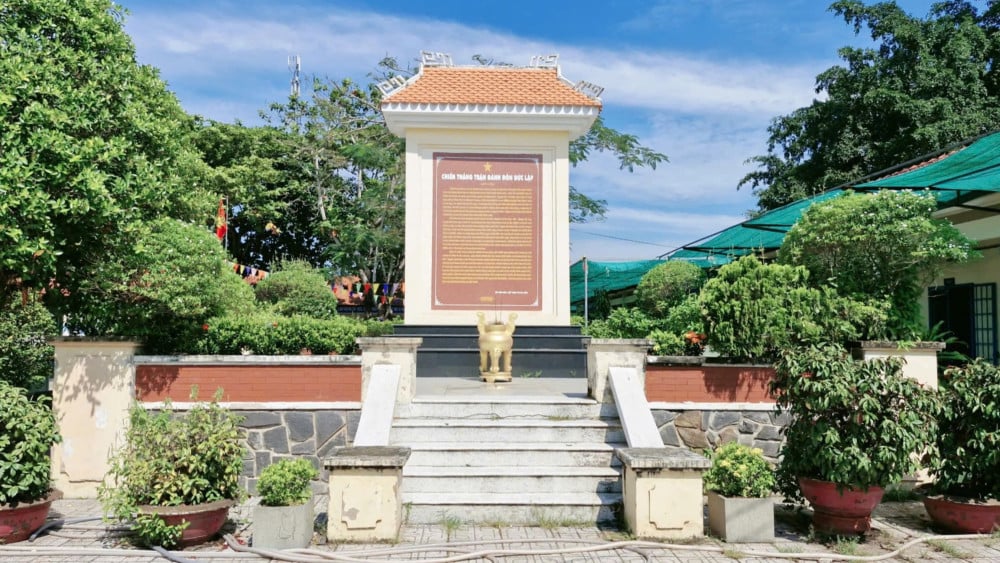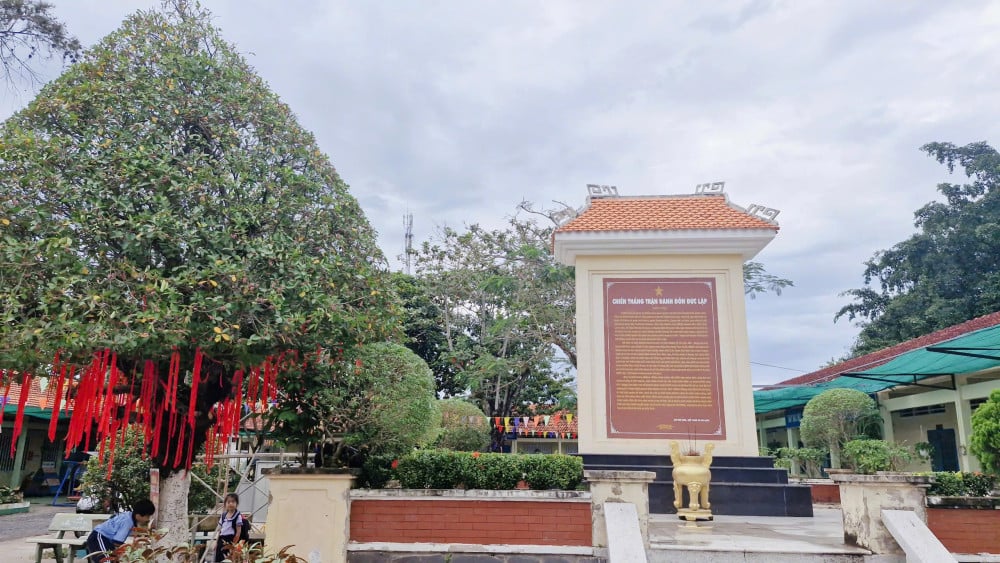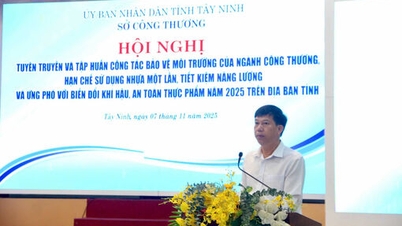In mid-1965, when the US “Special War Strategy” was in a deadlock, the US imperialists switched to implementing the “Local War Strategy”, sending massive expeditionary troops to land in the South. Judging that the US expeditionary troops would inevitably advance to the battlefield in Long An province, the Long An Provincial Party Committee decided to launch an operation at the end of 1965 to further expand the liberated zone in the South and continue to destroy the strength of the puppet 25th Division, and take some more weapons for the next mission to fight the US.

Memorial stele of the victory of the battle of Duc Lap Fort
Duc Lap - the origin of the tradition of "Loyalty and steadfastness, the whole people fighting the enemy"
Duc Lap Station was an important strategic position, connecting Hau Nghia with Cu Chi, both protecting the 25th Division Command in Duc Hoa town (present-day Duc Hoa commune) and maintaining contact with the puppet army forces in Cu Chi, Trang Bang; blocking the mobility corridor from An Ninh, Loc Giang (present-day An Ninh commune) down to Duc Hoa Ha area (Duc Hoa commune). Within the last 3 months of 1965, Long An army and people fought three major battles in Duc Lap, shaking the entire enemy defense system.
The first battle of Duc Lap (September 29, 1965): With daring raid tactics, Battalion 1 Long An coordinated with Battalion 267 of Military Region 8 and local troops of Duc Hoa district, Duc Lap militia and guerrilla forces to suddenly attack Duc Lap post on the night of September 28 to 29. After 45 minutes of fierce fighting, our troops destroyed Battalion 33 of the Special Forces, killed and wounded more than 500 enemies, including 3 American advisors, and captured many weapons and war vehicles. The opening victory dealt a strong blow to the spirit of the puppet army, affirming our initiative in attacking.
The second battle of Duc Lap (October 27, 1965): After the heavy losses in the first battle of Duc Lap, the puppet army in Hau Nghia District sent forces to Duc Lap to re-establish the defense system. At Duc Lap crossroads station, the 51st Special Forces Battalion was stationed, reinforced by a mechanized company and a reconnaissance platoon. The two Tam Giao stations in the Northeast and Northwest were each stationed by a security platoon; reinforced by 2 companies of the 1st Battalion, 46th Regiment, 25th Division, the puppet army camped in the strategic hamlets to protect the outer perimeter. At the same time, the puppet army also provided artillery support from Hau Nghia, My Hanh bases (Duc Lap commune and My Hanh commune today), Duc Hoa and Cu Chi.
To defeat the pacification plan on the Long An battlefield, we concentrated forces to organize the second battle of Duc Lap, including: Battalion 267 of Military Region 8, Battalion 1, Company 2 of the province, local troops of Duc Hoa and Ben Thu districts (Long An) and reinforced 2 special forces and reconnaissance platoons of the province, divided into 6 wings.
At 00:30 on October 27, 1965, our six attacking forces opened fire simultaneously, attacking the command post of the 51st Special Forces Battalion and shelling the puppet artillery bases in My Hanh, Hau Nghia, and Duc Hoa. After about 2 hours of fierce fighting, we destroyed more than 500 enemies, including the entire 51st Battalion Command, burned many vehicles and shot down 1 plane. The revolutionary forces sacrificed 40 comrades and injured 20 comrades. This was one of Long An's typical joint military operations, demonstrating the remarkable maturity of the local armed forces.
The third battle of Duc Lap (November 20, 1965): After the second battle of Duc Lap, the puppet army sent 2 battalions of the 46th Regiment of the 25th Division, 1 security company, and 2 militia platoons from Hau Nghia to carry out the plan to rebuild the forts and posts in Duc Lap.
Implementing the plan to attack and retaliate with the determination to liberate Duc Lap station, we organized the third battle of Duc Lap. The armed forces participating in the battle were Battalion 1 Long An, Battalion 267 Military Region 8, 2 special forces platoons, provincial reconnaissance, Duc Hoa local troops and Duc Lap guerrilla platoon.
On November 20, 1965, from 0:00 to 1:45, the commandos and infantry simultaneously attacked, coordinated to block reinforcements and attack helicopters and armored vehicles. After only nearly two hours, we burned two M113 vehicles, two helicopters, killed and injured more than 100 enemies, forcing the puppet army to panic and flee, abandoning Duc Lap post.
Three consecutive battles completely disintegrated the enemy defense system in the Hau Nghia - Duc Hoa area, expanding the liberated area, bringing the war closer to the gateway to Saigon. By the end of 1965, the entire Long An province had 57 liberated communes.
The enemy's Hau Nghia Province Chief at that time bitterly said: "Of the 220,000 people in the province, 200,000 lived in the liberated zone", the American advisors bitterly admitted: "The revolutionary forces achieved victory in most of the rural areas of Long An province". That was convincing evidence for the fact that at that time, Long An province was basically liberated.

The Memorial Stele commemorating the Victory of the Battle of Duc Lap Fort was erected at the old Duc Lap Fort area (currently located in the campus of Duc Lap Thuong A Primary School, Hau Nghia Commune, Tay Ninh Province).
The victory of Duc Lap is a shining symbol of the indomitable will, the spirit of national solidarity, of the steadfast, sharp and creative leadership of the Long An Party Committee, which contributed to the decisive failure of the "Special War Strategy", bringing the Long An revolutionary movement to its peak, becoming the direct rear of the Southeast battlefield. With these achievements, in 1967, the Central Committee of the National Liberation Front of South Vietnam awarded the Long An Party Committee and People the noble title "Loyal and resilient, the whole people fight the enemy".
Promoting heroic traditions in the new era
From July 1, 2025, implementing the project to rearrange administrative units according to the 2-level local government model, Long An and Tay Ninh provinces will enter the consolidation phase. The 1st Congress of Tay Ninh Provincial Party Committee, term 2025 - 2030, assessed that in the period 2020-2025, the province's GRDP growth rate is estimated at 6.73%/year. The economic scale by 2025 is estimated to reach nearly 352 trillion VND, an increase of 61.6% compared to 2020, ranking 10th in the country.
People's lives are constantly improving, GRDP per capita in 2025 is estimated to reach 4,776 USD (equivalent to 118.25 million VND), an increase of more than 56.8% compared to 2020. Agriculture continues to affirm its role as a pillar of the provincial economy. Industry continues to develop sustainably, attracting many capable investors and is the driving force for economic growth. The province's cultural, social and human development work has achieved many outstanding and comprehensive results. National defense, security and foreign affairs work continues to be strengthened, creating a solid foundation for socio-economic development.
Today, entering a new phase, with the goal of striving by 2030 for Tay Ninh to have a dynamic and sustainable economic development; to build a civilized society, a constructive government; and for the people to have a prosperous and civilized life... the Duc Lap victory has even more profound significance.
It is the flame that fosters the spirit of solidarity, self-reliance and self-improvement; it is the source of strength for the entire Party, government and people to continue promoting the spirit of "Loyalty - Resilience" in the cause of industrialization, modernization, digital transformation and sustainable development.
The Duc Lap victory will forever be a source of pride and a precious spiritual heritage, reminding present and future generations to constantly study, practice, and join hands to build a rich and beautiful homeland, worthy of the great sacrifices of our fathers and brothers in the revolutionary cause of liberating our homeland and country./.
Dang Anh
Source: https://baolongan.vn/60-nam-chien-thang-duc-lap-tu-hao-truyen-thong-kien-tao-tuong-lai-a205993.html



![[Photo] Da Nang: Hundreds of people join hands to clean up a vital tourist route after storm No. 13](https://vphoto.vietnam.vn/thumb/1200x675/vietnam/resource/IMAGE/2025/11/07/1762491638903_image-3-1353-jpg.webp)
































































































Comment (0)